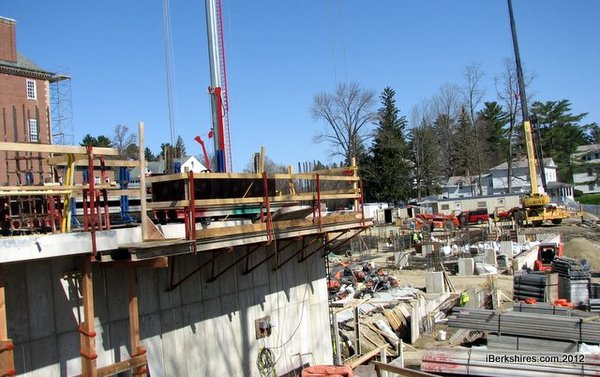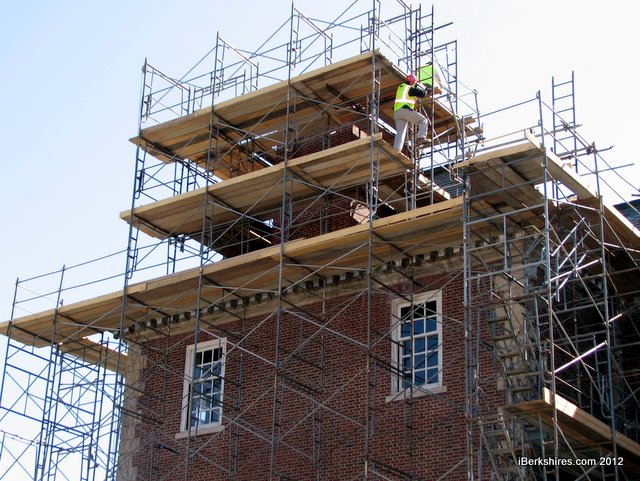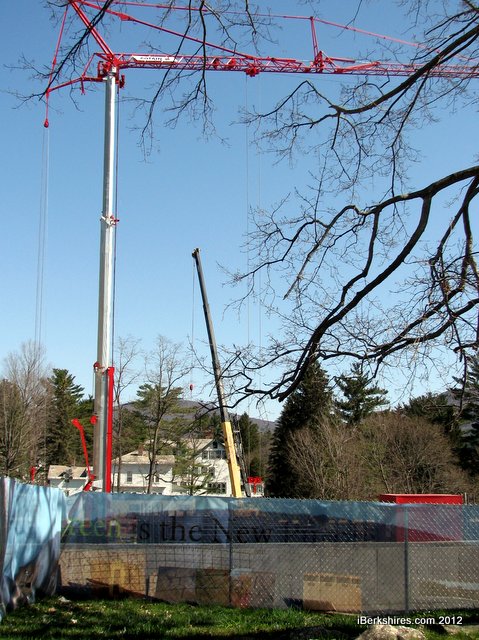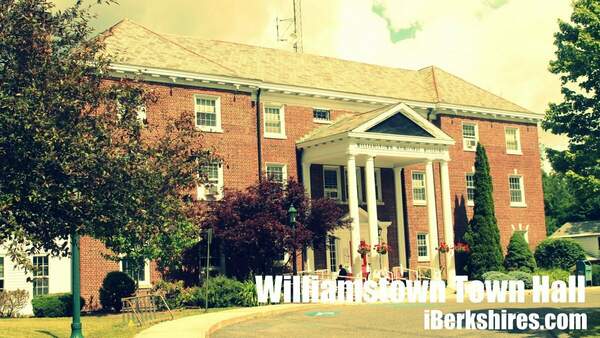
Williams Library Project Beginning To Take Shape
 Scaffolding covers the back of Stetson Hall. The mild winter has helped the project catch up after last fall's delays. |
In the fall, it was difficult to miss the library construction project in the heart of the college's campus because of the racket caused by the removal of a rock ledge where the school’s new library will be built.
This spring, the ledge is gone, the library is starting to take shape and one immense piece of construction equipment has been added to the town's skyline.
"The thing that just happened (April 12) was J.L. Marshall took delivery of a tower crane," Williams Librarian David Pilachowski said. "According to [project manager] Bruce Decoteau, it's the first time he's seen one on campus, and he was in charge of the Unified Science Center project and also the '62 Center.
"That's a piece of equipment you usually see in cities. You don't see it in Williamstown, Massachusetts. So it's pretty impressive.”
It is also another sign that the Stetson-Sawyer project is moving along.
The new Sawyer Library, scheduled to open in July 2014, will be located behind a renovated Stetson Hall, which opened in 1923 but was closed in 2008 when the college first envisioned an expansive library construction project.
Construction was delayed by a campuswide moratorium on building after Williams' endowment took a hit in a 2008 stock market collapse.
The moratorium was lifted in 2010, and ground was broken on the $128 million project last year.
Breaking the ground proved more difficult than planned. That was the reason for the booming that punctuated campus life this past fall and one of the reasons why the project was slightly delayed, Pilachowski said.
"I think the big surprise was the composition of the ledge," he said. "It was much harder than we thought. Our geologists looked at it and immediately understood why the contractors were having so much difficulty in breaking up the ledge.
 A giant tower crane looms over the work site behind Stetson Hall. |
Another snag for the project: the discovery of more PCBs than anticipated in the buildings that were cleared to make way for the new library.
Between the time spent to chip through the ledge and the time it took to properly dispose of the hazardous material, the project was about 40 days behind schedule at one point, Pilachowski said.
Mother Nature has helped the college get back on track.
"Thanks to the abnormally mild winter and a very good spring, we've been able to make up most of that time," he said. "I think as we close out the spring, we should be back on schedule.
"It turns out that's very important. You already think about the next winter because ... we'd like to be far enough along in the process that the site is closed in and we can work on finishing work during the winter months. It looks like we will be able to be back on schedule without a lot of additional overtime in the spring and summer. That will help with project costs."
The project is being managed by Milford-based Consigli Construction, which has a branch office on Water Street. Local subcontractors on the job include: Douglas J. Wooliver & Sons of Lanesborough, Countryside Landscape of Williamstown and J.H. Maxymilian, Eco-Genesis Corp. and Champlain Masonry of Pittsfield.
Although the booms that echoed through the "Purple Valley" last fall are gone, there still is the occasional noise from construction equipment. One day in early April, for example, nearly 20 concrete trucks arrived as the floor slab was poured for level one of the new Sawyer.
Like Stetson Hall (40,000 square feet), the new Sawyer Library (130,000 square feet) will stand four stories high when finished. But because the terrain behind Stetson slopes downward, the new building will be tucked behind its historic counterpart and not upstage it.
"Stetson is the main event, aesthetically," Pilachowski said. "Everyone loves Stetson. There's historic space in there and workmanship that's very difficult to replicate."
In addition to the more visible work on the new Sawyer this spring, contractors have begin drilling through the floors in Stetson and talking about running utilities and pouring new floors.
Pilachowski said he and other representatives from the library are in regular conversations with the contractors about how to configure space in both the new Sawyer and the renovated Stetson.
And as for the "old Sawyer?" The answer to that question may be one of the most exciting elements of the project, Pilachowski said.
Although the college did consider renovating and refurbishing 37-year-old Sawyer, it ultimately decided it would be more cost effective to build anew and reclaim the land where the 1975 structure now stands, Pilachowski said.
"One of the real virtues of the current project is we're creating a new green space where Sawyer had been, which I think people will be wildly pleased with," he said. "The space is going to be contiguous (to the Paresky Center lawn). There's a possibility of this space being used for public events."
Tags: building project, library, school building, Williams College,















